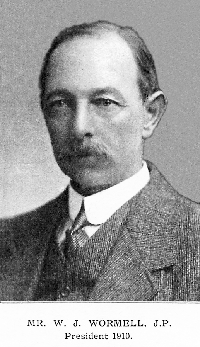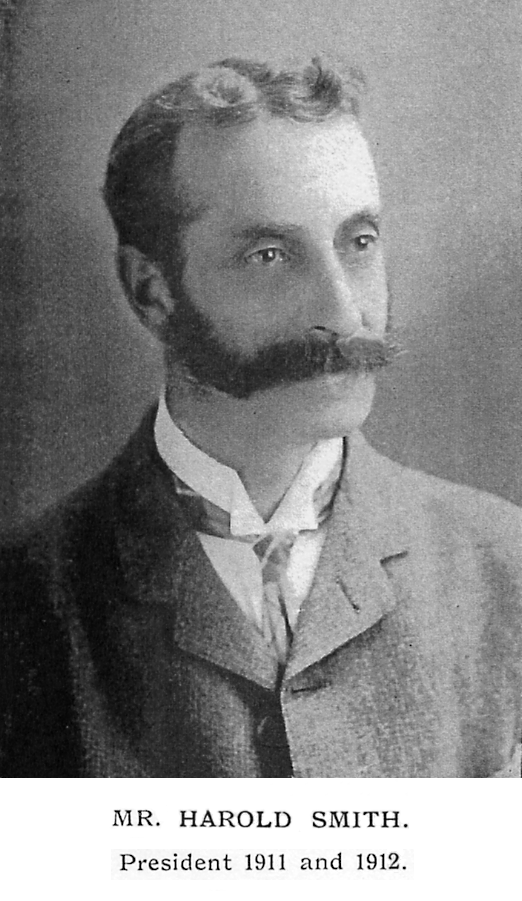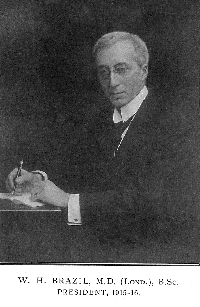Early Days of the Society
The Beginnings of the Society
The following is a brief account of the early days of the Society with notes on some of the personalities involved in its creation and administration. It is a compilation of data obtained mainly from early issues of the Proceedings, newspaper reports and the 1901 national census.
In November 1908 J.J.Ward the 'Coventry naturalist' gave a public Science Lecture on 'Britain's Quaintest Insects'.
Ward's lecture was reported in the Coventry Herald on November 28th. 1908 and in the same issue appeared a letter to the Editor from 'HP'. HP, commenting on Mr Ward's lecture, said that “...it suggested to me the desirability of following up the information derived from this, and other lectures of a similar character, by forming a Coventry Naturalists' Society. The need for such a society in a city like Coventry is obvious, since subjects such as botany, entomology and ornithology do not enter into the curriculum of the Education Committee.” (Note: HP was Herbert Powell who, in 1901 at the age of 28, was a General Toolmaker for a cycle tyre works.)
In response to HP's letter two further letters appeared in the Coventry Herald for December 5th. 1908:
(i) From E.F. Nicholls (a well known local naturalist) who welcomed HP's letter and wrote "The want of such a society has been continually expressed to me for 30 years". He went on to recount various earlier attempts to form a naturalists' society in Coventry. ( Note: In 1901 E.F.Nicholls was a watch-lever maker.)
(ii) From John J. Ward, who noted "with interest" the letter from HP regarding the formation of a Coventry Naturalists' Society, and continued "if sufficient interest is shown in this matter I shall be pleased to associate myself with the movement and render any assistance in the organisation of such a society that my experience of natural history matters might prove of benefit"
On 19th February 1909 the Coventry Herald reported the 'Formation of a Naturalists' Society' A meeting had been held on 14th February, in the Technical Institute, for the purpose of considering the establishment of an association, to be known as the “Coventry Natural History and Scientific Society". Mr W. J. Wormell presided.
After some discussion, Mr W. R. Goate moved a resolution that a “Coventry Natural History and Scientific Society” be formed, and Mr J. J. Ward, in seconding, said that Coventry, from a natural history point of view, was far and away behind the times, because in Coventry there were a large number of people whose intelligence stopped at their work, football, and backing a winner. He considered that such a society would be of great educational benefit for all classes in the town.
Several speeches followed, each speaker welcoming the formation of the society, and the resolution was carried.
Mr. W. R. Goate was elected as president; and Councillor Poole, Mr. W. J. Wormell, Mr. J. I. Bates, and Mr. Bell as vice-presidents; Mr. Wormell was appointed treasurer, and Mr. H. Powell secretary.
The subscription was fixed at 4s. annually, payable either quarterly or annually as preferred (it is worth noting that 4s, or 20p, in 1909 equated to about £15.50 in 2008 – using the retail price index – or about twice the current subscription)
It was suggested a lecture should be organised to give the Society a send-off, and Mr. J. J. Ward was asked to deliver such a lecture. He consented to do so “...conditionally, that a room for the purpose could be engaged and a good audience guaranteed”. On April 3rd. 1909 a successful and well attended inaugural public lecture, entitled “Glimpses into Nature's Ways”, was given by Mr J. J. Ward.
The new society subsequently organised a series of rambles and reports of those held in May 1909 to Bubbenhall, Brinklow and Corley were published in the Coventry Herald.
Some Presidents of the early years
W.R.Goate - President 1909 - 1910 (founder member)
William Ranby Goate was a solicitor by profession, living at 6 The Quadrant. He was a conserative councillor and Mayor in 1901.
He was the Secretary of St Micheal's Masonic Lodge and a trustee of the Coventry Wesleyan Chapel.
Treasurer 1911-12, 1912-13, 1914-15, 1915-16, 1916-17, 1918-1919.
|

|
|
|
W.J.Wormell - President 1910 - 1911 (founder member)
William J. Wormell was a slate merchant, did slating, tiling and was a Stone Contractor, operating from Regent Street in 1901. Wormell's Roofing Centre still exists in Regent Street today. He was the Society's first Treasurer.
|

|
|
|
Harold Smith - President 1911 - 1913 (founder member)
Mr. Smith came to Coventry sometime between 1875-77 and lived at Pinley House. He was a keen sportsman, having played cricket for the county of Stafford, and was one of the first to play tennis. Much of his time in Coventry was spent in active sport such as hunting with the Atherstone and North Warwickshire Hounds and also with Mr Frank Phillips' pack of Harriers (at Willenhall) and fishing. He did not shoot as he abhorred the idea of inflicting possible suffering on birds. Harold Smith was a prominent figure in golfing circles and his association with several other local gentlemen led to the formation of Coventry Golf Club for which he was the first hon. secretary - a post he held over 25 years until his untimely death in 1914 aged 65.
Mr Smith was an ardent naturalist and became an active member of the Society. He had made a study of the lives of the fox, hare and fishes and his interests in natural history led him to build up a collection of butterflies, moths and beetles during the late 1800s but there were few labels to show where they came from. He also had a large collection of birds' eggs. These collections now form part of the Natural History collections of the Herbert museum.
Aside from the world of natural history, Harold Smith, a man of independent means, also had a connection with the local engineering industry in his collaboration with W. M. Hillman in the production of motor cars.
|

|
|
|
J.J.Ward F.R.E.S. - President 1913 - 1915 & 1932 - 1933 (founder member)
|

|
|
John Joseph Ward was a native of Coventry, born on March 28th 1875 and died on the 8th of January 1947 at the age of 71. He served an apprenticeship as a lithographic printer and became a Freeman of the city. In 1902, at the age of 27, J. J. Ward abandoned the printing trade and embarked on a new career as a free-lance naturalist and photographer. By 1908 he had lectured 'with great success' in many parts of Britain (including eight times in Liverpool and four in Birmingham). He came to be known as the 'Coventry naturalist' and was a pillar of the Society. For further details of J. J. Ward's life and work:- Click Here
|
|
|
Dr Walter Henry Brazil
- President 1915 - 1917
Dr. Brazil and his two sisters, Amy and Angela moved from Lancashire to Coventry in 1911 where they lived at the Quadrant. They joined the Society in 1911. By profession a medical practitioner, Dr. Brazil's other interests were in horology – he collected and repaired old clocks – and in botany. . He participated actively in the indoor and outdoor meetings of the Society and, with J.J. Ward, he was a trustee of the Society until 1940.
|

|
|
|
Frederick William Shotton M.B.E, F.R.S
|

|
- President 1930 - 1931 & 1973 - 1974
|
In 1921 the Society's rules were changed so that 15 year old Bablake pupil Fred Shotton could become a member. In 1925, at the age of 19 and while studying geology at Cambridge, he gave a lecture to the Society on some of the work he had been doing with Jack Edwards on the "Upper Carboniferous Conglomerates of Warwickshire".
He had an illustrious career as a geologist and in 1949 took up the post of Lapworth professor of geology at Birmingham University until his retirement in 1974 and was Vice Principal of the University 1965 - 71.
He was the Society's Treasurer for the period 1984 - 90 and Editor of the "Proceedings" 1930 - 40 & 1948 – 59 (the seven year gap in publication of the Proceedings resulted from difficulties caused by the war period).
He gave many lectures to the Society and had a wide interest in entomology, especially in beetles, plant bugs, caddis flies and macro and micro moths. His study of the land and freshwater snails contributed greatly to the knowledge of their distribution in Warwickshire and elsewhere and he also had a long-term interest in fungi - for many years he led the Society's annual fungus forays. This interest he shared with his first wife, Alice whose paintings of fungi were presented to the Society. Fred Shotton's collections of insects and snails were donated to the Herbert museum.
In 1960 he founded the F J Shotton Trust Fund in memory of his father Fredrick John Shotton.
|
Other notable Early Members of the Society
Angela Brazil
- Vice President 1930 - 1940
Came to Coventry in 1911 with her brother and kept house for him. She joined the Society with her brother and sister Amy, in 1911.
Angela Brazil was well known as the author of 49 school stories for girls and sold 3 million copies of her books in Britain during her life time.
She was one of the founding members of the City Guild, a forerunner of the Herbert Museum.
A skilled painter of flowers and fungi, her paintings are now housed in the collections of the Herbert museum.
John William (Jack) Saunt A.L.S.
Jack Saunt joined the Society when he moved to Coventry from Nottingham in 1915. He was an expert amateur entomologist and during his time in Coventry worked mainly on certain groups of Diptera (Larvarvoridae, Syrphidae and Trypetidae) and Hymenoptera (sawflies) and added many
species to the county lists and at least one to the British list.
In 1925 Jack was honoured for his work by the Linnaean Society who elected him an Honorary Associate - a rare distinction reserved for amateur naturalists who have made outstanding contributions to knowledge.
Jack served on the committee during 1930 and 1931 and in 1937 moved again and the Society made him an Honorary Life Member. This time his work took him to the Isle of Wight where he remained until his death in 1958.
After his death a large part of his collections was secured by the Herbert museum.
John Henry (Jack) Edwards F.S.A - Treasurer 1919 - 1925 & Secretary 1928 – 1933
Jack Edwards moved to Coventry in 1909 and probably joined the Society soon after arriving in the City. During the inter-war years and for the immediate post WWII years he had a small boot-repairing shop in Union Street. His early interests were in geology and when home on leave from France in 1918 (where he was serving with the R.A.S.C.) he met the young Fred Shotton, then aged about 12, to whom he gave four fossils. Fred later recalled that the gift had “so stirred my imagination that I decided there and then to be a geologist, a decision which I have never regretted.” Gradually Jack's main interests changed to archaeology and he is well known for his work on the excavation of Brandon Castle and for a number of important discoveries at Baginton including Roman dwellings, a Roman cemetery and an Anglo-Saxon cemetery and he also carried out the excavation of the 13th Century Baginton Castle. The many relics he found, including the Baginton hanging bowl, were all presented to Coventry Museum (which later became the Herbert museum).
Jack gave up his business in 1950 and retired to Bedfordshire where, two years later, he collapsed while engaged in excavating an Iron Age site and died the following day.
Frederick John Shotton JP (founder member)
F.J.Shotton came to Coventry from Birmingham in 1896 and founded the Albion Drop Forging Company Ltd.
He was a member of the Society for many years and was the auditor from 1930 - 1950. He was always ready to help the Society practically and financially. The F.J.Shotton Trust Fund was founded in his memory by his son, Frederick William Shotton.
Compiled by R.E. & P. Cooke.





